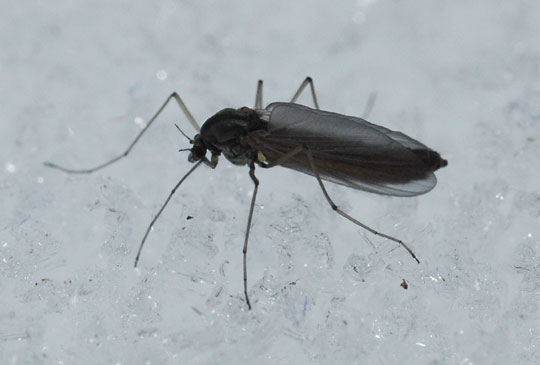By Jane Mazack
Exploring Daley Creek is a blog series that investigates the biological and physical processes at work in a small stream in Minnesota and what it means to consider rivers in a scientific framework. Follow along to learn more about life in the stream and its broader connections, both in the present and as we consider a future of climate change.
On a cold but sunny January day in southeastern Minnesota, you may see a strange sight: thousands of insects emerging from the waters of Daley Creek, walking upon its snowy banks, and swarming in the chilly air. If you look closely, you’ll notice that they look a bit like mosquitoes, but with one important distinction – they have no proboscis, and so they cannot bite you. These cold-adapted flies are chironomids, also known as midges.
Female adult midge on snow (Species: Diamesa mendotae). Photo by the Chironomid Research Group, all rights reserved.
Each adult midge began its life cycle as an egg in the streambed of Daley Creek. When water temperatures fell below 10°F in the fall, the egg began to grow and develop. Over the next two months, it completed four larval stages, pupated, rose to the surface of the water, and emerged as an adult – groundwater from the Karst limestone prevented the water from freezing. The newly emerged adult crawled up the snowy bank in sub-freezing January weather, where she found a mate. The eggs she laid will begin a second generation, which will be completed as winter turns to spring.
So, if you’re in Minnesota and you think you see a mosquito in January, think again. It may not be a mosquito at all.
The writing and analysis of this blog series were conducted under the auspices of the John E. Sawyer Seminar “Making the Mississippi: Formulating New Water Narratives for the 21st Century”. Sawyer seminars are funded by the Andrew Mellon Foundation; further information about “Making the Mississippi” can be found here.
